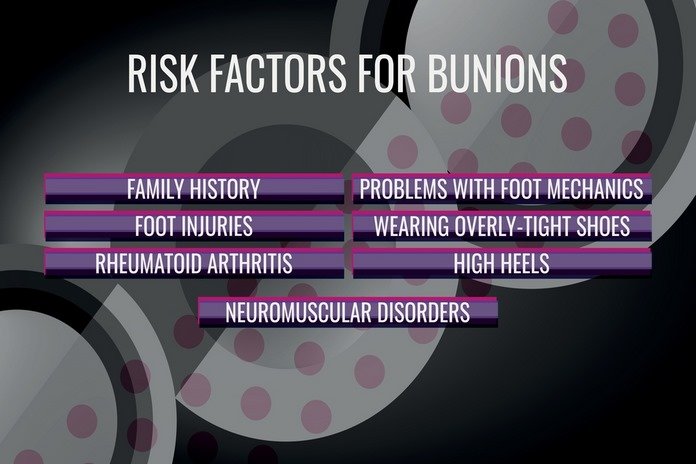Bunions Risk Factors

Feet problems normally begin in early adulthood. As we grow, our feet expand and the problems tend to get worse. (5) Factors that might contribute to bunions consist of:
- Genetics: Bunions might run in your family that is why you are dealing with it
- Foot structure: Poor or weak structure of the foot might give rise to bunions
- Leg length: If each of your legs is bigger than the other one, you might have a bunion on the big feet of the bigger one
- Arthritis: Certain kinds of arthritis make bunions more likely. This is specifically true of inflammatory kinds of arthritis like rheumatoid arthritis
- Occupation: If your job needs you to be standing all the time, you might be at an increased chance of having bunions. Ballet dancers are susceptible, particularly to having bunions because of extreme pressure on your feet
- Shoes: Wearing tight shoes or high heels might form bunions more likely. That is why they occur more in women in comparison to men
- Rheumatoid arthritis: Having such an inflammatory situation might make more chances to have bunions
- High heels: Wearing heels that are higher forces your toes into the top of your shoes, sometimes crowding the toes
- Bad fitting shoes: People who worse shoes that are too narrow, too tight, or too pointed are more chances to have bunions
Are you thinking if you are at the edge of having bunions? The statistics of the recent studies have shown that almost 23% of the people that ranges from 18 years to 65 years of age have formed bunions. When you have a look at populations 65 and above, that percentage jumps to almost 35%. Therefore, bunions are sometimes taken as an inevitable condition concerning growing older, just like how arthritis has sometimes taken, this might not be farther from the truth. Avoiding the formation of bunions as we get older might be a difficult task, but thinking bunions are a bone deformity, they can be anything but inevitable or natural.
Among the statistics mentioned previously, the good size of such individuals impacted by the development of bunion has inherited their vulnerability to such deformity from their relatives. This means that someone whose mother and grandmother have both bunions development is much more susceptible to having bunions themselves. It runs in the family, so take it seriously! The reason for hallux valgus is not well-defined always and varies from person to person. for such reason, it requires more attention to the factors that might put you at risk of their onset, and that are well-known. For big feet to be well aligned, there must be a balance between the different muscles that might act at such a level.
This balance is sensitive to internal or external factors that act as facilitating reasons. Thus, there is an agreement on a few factors that act as facilitating its formation:
- Being female
- A familial disposition
- Kind of footwear
- Other risk factors
- Egyptian foot
- Hyprlaxity
- Age
- Flat foot
- Obesity
- Menopause
